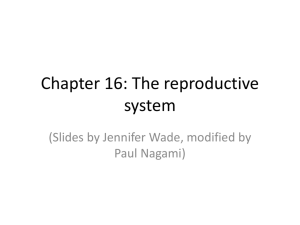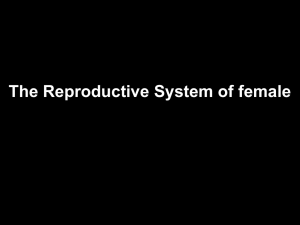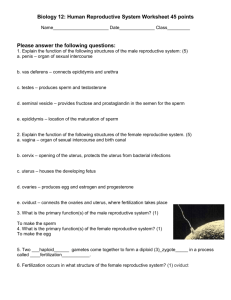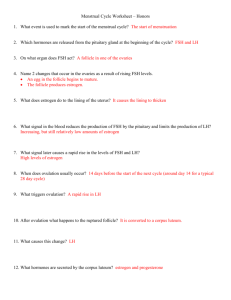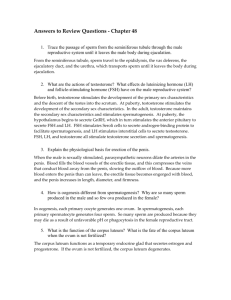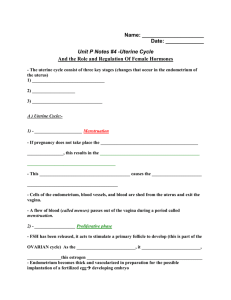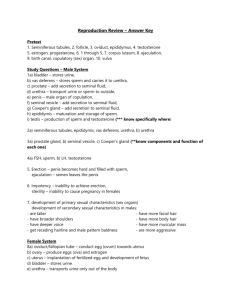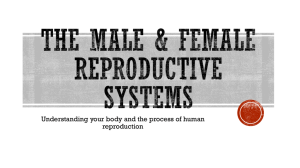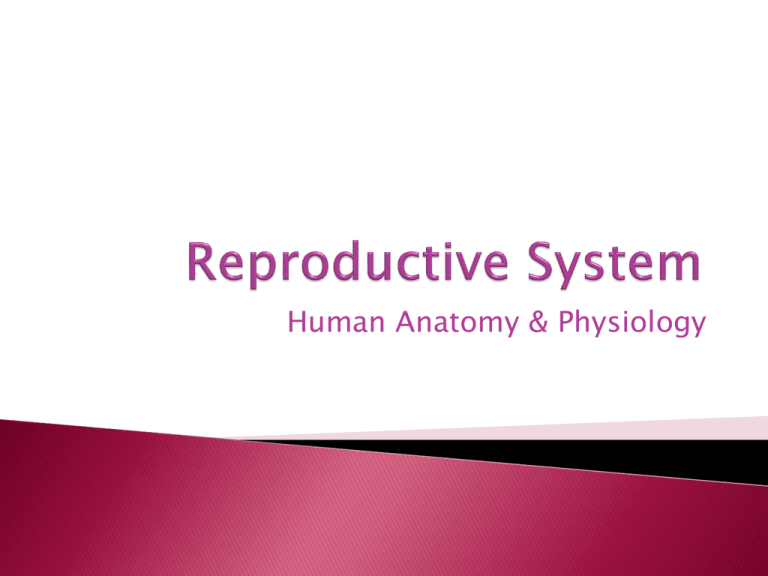
Human Anatomy & Physiology
Labeling
Testis
Epididymis
Scrotum
Vas
deferens
Prostate
Seminal
vesicle
Urinary
bladder
Rectum
Penis
Cowper’s
Glands
Urethra
Testes (2 of them)
◦ Male gonads
◦ Seminiferous tubules
Site of sperm formation in the
testes
FSH stimulates sperm
production
◦ Leydig cells (interstitial cells)
Scattered among the
seminiferous tubules
Produce testosterone
LH stimulates testosterone
production
◦ Epididymis
Tube in the testes where
sperm gain mobility
Suspended in the scrotum
Sperm leave the testes
and enter the epididymis
Tightly coiled tube, 20
feet long
Located in the scrotum,
just above the testes
Function
◦ Store sperm until it matures
and gains motility
◦ Produce fluid which
becomes part of semen
Head
Consists of:
a head containing
the nucleus
a midpiece
containing energyreleasing
mitochondria
Nucleus
Midpiece
Mitochondria
Tail
a tail, which
propels the cell
forward
Copyright Pearson Prentice Hall
Function
◦ Receives sperm from
the epididymis
◦ Temporarily stores
sperm
Tube that is cut
during a vasectomy,
the procedure to
produce sterility in
males
2 small tubes
located behind the
bladder
Function
◦ Produce a thick,
yellow, rich in sugar
that nourish the
sperm
◦ This fluid composes
a large part of the
semen
2 short tubes
Carry sperm and
fluids known as
semen through
the prostate gland
into the urethra
Located below the
bladder
Produces an alkaline
secretion that increases
sperm motility and
neutralizes the acidity of
the vagina
During ejaculation, the
prostate gland
◦ Contracts causing the
expulsion of semen
◦ Closes off the urethra,
preventing urine passage
through the urethra
2 small glands
located below the
prostate gland
Secrete a mucouslike fluid that
serves as a
lubricant for
intercourse and an
alkaline fluid to
decrease the
acidity of the urine
residue in the
urethra
Tube that extends
from the bladder,
through the penis,
to the outside of
the body
Carries semen and
urine
5-7 inches long in
male
External male reproductive organ
Glans penis - enlarged structure
on the end of the penis
◦ This is covered by the prepuce or
foreskin
◦ The foreskin is removed in a
procedure called circumcision
Penis is made of spongy, erectile
tissue
◦ During sexual arousal, the erectile
tissue fills with blood from the
arteries, causing an erection
Functions
◦ male organ of copulation/intercourse
◦ Elimination of urine from the bladder
The male gonads, or testes, consist of highly coiled
tubes surrounded by connective tissue
Sperm form in these seminiferous tubules
From the seminiferous tubules of a testis, sperm pass
into the coiled tubules of the epididymis
During ejaculation, sperm are propelled through the
muscular vas deferens and the ejaculatory duct, and
then exit the penis through the urethra
Three sets of accessory glands add secretions to the
semen, the fluid that is ejaculated
◦ The two seminal vesicles contribute about 60% of the
total volume of semen
◦ The prostate gland secretes its thin milky fluid
containing enzymes and sperm nourishment directly
into the urethra
◦ The Cowper’s gland secretes a clear mucus before
ejaculation that neutralizes acidic urine remaining in
the urethra
Androgen: Testosterone
◦ Primary sex characteristics
development of the vas deferens and other ducts
development of the external reproductive structures
sperm production
◦ Secondary sex characteristics
Deeper voice
Axillary and pubic hair
Chest and facial hair
Lengthen bones
Increased size of testes for sperm production
Gonadotropic Hormones
◦ Released from the Anterior Pituitary Gland
Follicle-Stimulating Hormone (FSH)
stimulates production of sperm
Luteinizing Hormone (LH)
stimulates secretion of testosterone
The male hormone pattern is continuous.
The principle male sex hormones are
androgens specifically testosterone.
Gonadotropin-Releasing Hormone (GnRH)
◦ Produced by the hypothalamus
◦ Regulates FSH and LH levels
◦ Controlled by negative feedback from FSH and LH
Copyright Pearson Prentice Hall
Process of sperm production
Continuous process that begins at puberty
and continues through life
LH induces Leydig cells to produce
testosterone
Together with FSH, testoterone stimulates
sperm production in the seminiferous
tubules.
Cancer of the testicles
Frequent in men 2035
Highly malignant and
spreads quickly
Treatment
◦ Orchiectomy, radiation
ACS
◦ American Cancer Society
◦ Recommends STE
◦ Self testicular exam
Female gonads
2 small almond-shaped
glands, located in the
abdominal cavity, attached
to the uterus by ligaments
Contains thousands of
small sacs called follicles
Each follicle contains an
immature egg or ovum
Produce the hormones
estrogen and progesterone
Responsible for the
secondary sex
characteristics – breasts,
hips widen, body hair
The maturing and
release of an egg
every
Occurs every 28
days
If egg is not
fertilized, the body
sheds the lining of
the uterus and
menstruation
occurs
2 of them
5 inches in length
Attached to the upper
part of the uterus
Function
◦ Move the ovum from the
ovary to the uterus
◦ Cilia and peristalsis
keep the ovum moving
◦ Site of fertilization, the
union of the egg and
sperm
Hollow, muscular, pearshaped organ
3 parts
Function
◦ Fundus – top
◦ Body – middle
◦ Cervix – narrow bottom
◦ Organ of menstruation
◦ Allows for the development and
growth of the fetus
◦ Contracts during birth to aid in
the expulsion of the fetus
Layers
- endometrial
- If fertilization does not
occur, this lining deteriorate,
resulting in menstruation
Muscular tube that
connects the cervix to the
outside of the body
Function
◦ Passageway for menstrual
flow
◦ Receives sperm and semen
from the male
◦ Female organ of copulation
◦ Birth canal during delivery
of the infant
2 small glands on either
side of the vaginal
opening
Secretes mucous for
lubrication during
intercourse
<>
Collective name for
the external female
genitalia
Includes
◦ Mons pubis - pad of
fat
◦ Labia majora – outer
folds of tissue covered
with pubic hair
◦ Labia minora – inner
folds of tissue
◦ Perineum – area
between the vagina and
anus
Mammary glands
Contain lobes that
surface at the nipples
Function
◦ Secrete milk – lactate
after childbirth
Female Reproductive System
Benign or
American Cancer
Society
recommends SBE
Self Breast
Examination
every month for
adult females at
the end of
menstruation
ACS recommends
a baseline test
between 35-40
Lumpectomy
Simple
mastectomy
Radical
mastectomy
Radiation
Chemotherapy
Detected by a
PAP smear
Treatment
◦ Hysterectomy
◦ Removal of cervix
and uterus
Growth of
endometrial tissue
outside the uterus
Can occur during
surgery, through
the fallopian
tubes, blood and
lymph
Group of
symptoms that
appear 3-14 days
before
menstruation
Cause – unknown
Related to
hormonal changes
or biochemical
imbalance
Section 39-4
Fallopian tube
Day 2
Day 3
Day 1
Day 4
4 cells
Morula
Day 7
Blastocys
t
2 cells
Fertilization
Zygote
Day 0
Implantation
of blastocyst
Uterine
wall
Ovary
Egg released
by ovary
Most common malignancy of US women
180,000 American women
1 in 8 women will develop breast cancer.
Arises from epithelial cells of the ducts, small
clusters of cancer cells grow into a lump in the
breast from which cells eventually metastasize.
Risk factors:
1. early onset of menopause
2. no pregnancies or first pregnancy late in life
3. history of breast cancer
4. silicone breast implants
5. high estrogen concentrations
6. cigarette smoking
7. excessive alcohol intake
8. hereditary defects
70% of women who develop breast cancer have no
known risk factors for the disease.
Changes in skin texture
Puckering
Leakage from nipple
Lumps in breast
Monthly self breast exam
Mammogram
◦ x-ray that can detect cancer smaller than 1 cm,
recommended every 2 years from women between
40-49 and then yearly from age 50.
Radiation
Chemotherapy
Surgery followed by radiation or chemo
Lumpectomy- only cancerous lump
removed.
Simple masectomy- removal of breast
tissue only.
Radical mastectomy- removal of entire
affected breast, muscles, fascia, and lymph
nodes.
Bacterial
◦ Chlamydia – 3 million cases every year
◦ Syphilis
◦ Gonorrhea
Viral
◦
◦
◦
◦
Hepatitis B
Genital Herpes
Genital Warts
HIV (AIDS)
Hormone
Produced by
Function
Testosterone
Testicles
Male sex traits
FSH
Pituitary
Stimulates egg/sperm
dvlp
Stimulate estrogen
LH
Pituitary
Stim. Testosterone
Release of egg, corpus
luteum, progesterone
Estrogen
Ovaries
Female sex traits
Progesterone
Corpus luteum
Maintains Uterus lining
Copyright Pearson Prentice Hall
CYCLIC
OOGENESIS
FERTILIZATION
PREGNANCY
DELIVERY
MENOPAUSE
FOLLICULAR PHASE
LEUTEAL PHASE
ONLY INTERRUPTED BY PREGNANCY
ENDS AT MENOPAUSE
PRIMARY OOCYTE IS IN A PREPARATORY
PHASE
FIRST MEIOTIC DIVISION
OVULATION
ESTROGEN SECRETED FROM FOLLICLE
HYPOTHALAMUS
GRH +
ANTERIOR PITUITARY
FSH
LH
OVARY
INHIBIN
LOW LEVELS OF ESTROGEN
AFTER OVULATION
DEVELOPMENT OF CORPUS LUTEUM
SECRETES PROGESTERONE AND ESTROGEN
DEGENERATES AFTER 2 WEEKS IF NOT
FERTILIZED
HYPOTHALAMUS
GNRH +
ANTERIOR PITUITARY
LH
OVARY
CORPUS LUTEUM
MODERATE
LEVELS OF ESTROGEN
HIGH LEVELS OF
PROGESTERONE
Ovulation
Copyright Pearson Prentice Hall
Copyright Pearson Prentice Hall
CORPUS LEUTEUM DEGENERATES
ESTROGEN AND PROGESTERONE LEVELS
FALL
MENSTRUAL PHASE INVOLVES SLOUGHING
OF PREPARED ENDOMETRIUM
NEW CYCLE STARTS-NEW FOLLICLES
DEVELOP AND BEGIN SECRETING ESTROGEN
HYPOTHALAMUS
GNRH +
ANTERIOR PITUITARY
FSH
LH
OVARY
MATURE FOLLICLE
OVULATION
HIGH LEVELS OF ESTROGEN
IN OVIDUCT
SPERM DEPOSITED IN VAGINA AT EJACULATION
TRAVEL TO OVIDUCT TAKES A LITTLE OVER 1/2 HOUR
CERVICAL CANAL IS OPEN DUE TO ESTROGEN BEING HIGH
AND REMAINS OPEN TWO TO THREE DAYS
SPERM ENTER UTERUS AND ARE CHURNED AROUND
WHEN REACH OVIDUCT, SMOOTH MUSCLE CONTRACTIONS
PROPELL THEM ONWARD
MATURE EGG RELEASES A CHEMOTACTIC AGENT
OUT OF SEVERAL HUNDRED MILLION ONLY A FEW THOUSAND
MAKE IT
TAIL OF SPERM MANEUVERS IT FOR FINAL PENETRATION
PLACENTA IS ORGAN OF EXCHANGE
PLACENTA SECRETES HUMAN CHORIONIC
GONADOTROPIN (HCG)-PROLONGS LIFE OF
CORPUS LUTEUM
ESTROGEN AND PROGESTERONE LEVELS EVEN
HIGHER NOW
AFTER 10 WEEKS PLACENTA TAKES OVER
POSITIVE FEEDBACK
CERVICAL DILATION
DELIVERY
DELIVERY OF PLACENTA
MAMMARY GLANDS OR BREASTS
MILK PRODUCING GLANDS AND FAT
ACTION OF ESTROGEN AND PROGESTERONE IS TO
PREPARE GLANDS DURING PREGNANCY
ALSO BLOCK PROLACTIN’S STIMULATION
OXYTOCIN-MILK EJECTION
SUCKLING TRIGGERS OXYTOCIN RELEASE
Induced by increased LH, FSH, estrogen, and
progesterone hormone levels
◦
◦
◦
◦
Axillary and pubic hair
Widen pelvis
Enlarge mammary tissue
Begin menstrual cycles
Occurs in upper 1/3 of Fallopian tube
Once one sperm enters, egg membrane
changes
Fertilized egg = zygote
Implanted into thick walls of uterus
Chorion membranes dig into uterus to form
placenta
Embryo supported via umbilical cord
Once pregnant, progesterone levels stay high
in mom
Heart develops first
Neural tube develops
All body systems appear by Week 8 – Now a
Fetus
Mostly growth
Looks more like a baby
Some preemies survive at this stage
More growth
Kicking, rolling, stretching
Eyes open – Week 32
Lungs mature
Rotates to head-down
position
Labor
◦ Uterine contractions begin
◦ Cervix dilates to 10 cm.
Birth
◦ Uterus pushes baby through vaginal canal
Placenta delivered after
Gonadotropic Hormones
◦ Follicle-Stimulating Hormone (FSH)
Male: stimulates production of sperm
Female: stimulates ovary follicles to produce estrogen
◦ Luteinizing Hormone (LH)
Male: stimulates secretion of testosterone
Female: stimulates follicle to secrete estrogen, triggers
ovulation, and stimulates follicle to produce
progesterone
Estrogens
◦ Female: affects fat deposits in breasts and hips,
water retention, calcium metabolism, uterus and
vagina development, and pubic and auxiliary hair
development, broadens the pelvis and determines
sexual behavior
Progesterone
◦ Female: inhibits uterus contractions and growth of
new follicles immediately after ovulation if there is
no fertilization of an egg, and maintains pregnancy
if there is fertilization
Human Chorionic Gonadotropin (HCG)
◦ Female: keeps the corpus luteum from deteriorating
and stops the normal menstrual cycle if fertilization
occurs
Oxytocin
◦ Female: stimulates uterus contractions during birth
and stimulates milk flow from breasts after birth
The male hormone pattern is continuous.
The principle male sex hormones are
androgens.
Gonadotropin-Releasing Hormone (GnRH)
◦ Produced by the hypothalamus
◦ Regulates FSH and LH levels
◦ Controlled by negative feedback from FSH and LH
The female hormone pattern is cyclic.
Humans and other primates have menstrual
cycles and other mammals have estrous
cycles.
Hormones (specifically GnRH, FSH, LH,
estrogens, and progesterone) coordinate the
menstrual cycle with the ovarian cycle.
Follicular Phase
GnRH stimulates pituitary to secrete FSH and LH.
FSH stimulates follicle growth.
Follicles slowly secrete estrogens.
Pituitary hormones keep FSH and LH levels low.
Increasing levels of estrogens stimulate the
hypothalamus to secrete GnRH.
◦ GnRH stimulates FSH and LH secretion.
◦ Follicle increases estrogens secretion.
◦ Ovulation.
◦
◦
◦
◦
◦
Luteal Phase
◦ Leftover follicular tissue forms the corpus luteum.
◦ LH stimulates the corpus luteum to secrete
estrogens and progesterone.
◦ The hypothalamus and pituitary stop secreting
GnRH, FSH and LH.
◦ The corpus luteum disintegrates.
◦ Estrogens and progesterone levels decrease.
◦ The hypothalamus and pituitary start secretion
again.
◦ There is enough LSH to stimulate new follicles to
grow.
Menstrual Flow Phase
Proliferative Phase (similar timing as the
follicular phase in the ovarian cycle)
◦
◦
◦
◦
Estrogens from the follicles stimulate the uterus.
The endometrium thickens.
The uterus is preparing for implantation.
Ovulation.
Secretory Phase (parallel to the luteal phase in
the ovarian cycle)
◦ Estrogens and progesterone from the corpus
luteum stimulate the endometrium to further
thicken, the arteries in the uterus to grow, and the
endometrial glands to grow.
◦ Artery spasms stop blood flow to the endometrium.
◦ Menstruation.
Occurs in human females between the ages of
46 and 54
When ovulation and menstruation stop
The ovaries stop responding to FSH and LH
and therefore stop producing estrogens.
Most other species remain capable of
reproduction their whole life.
The sixth edition Campbell biology textbook
http://users.rcn.com/jkimball.ma.ultranet/Bi
ologyPages/H/Hormones.html
http://www.uwyo.edu/wjm/repro/fig2-7.htm
http://www.biology.arizona.edu/Human_Bio/
problem_sets/Human_Reproduction/human_r
eproduction.html
http://kidshealth.org/misc/movie/bodybasic
s/bodybasics_female_repro.html
http://www.youtube.com/watch?v=SkcddD0L
GlM
http://www.youtube.com/watch?v=qCXG_Zfq
Aks&feature=channel

